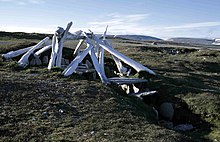Qarmaq



The earth or sod hut known as Qarmaq served the Eskimos as accommodation from the time of their Thule ancestors until the 1950s, mainly during the cold season. The Qarmaq was usually preferred, but in winter, especially when traveling, often lived in an igloo (snow house). In summer the Eskimos lived in tents they had made themselves out of animal skin or canvas and wandered around in search of food.
The construction of a Qarmaq usually began in early August, when autumn approaches. For this purpose, a recess was created in the ground and a roofing frame was built, large enough for a family to live in one room. In the absence of wood, mostly bones, preferably whale bones, were used for this. Shortly before the cover at the time of the first snowfall, skins or canvas were stretched over the frame. This was covered with dry moss from the tundra that women and children had already collected. Then a second sheet of tent was covered over the moss pad and attached to the frame. Winter snow, cut into blocks by the men with long snow knives, provided additional protection from the outside.
The outer covering was not only exposed to the elements, but was occasionally gnawed by predators. Because canvas was relatively expensive and difficult to obtain, women often had to repair it regardless of the weather. In contrast, the frame usually survived the summer and could be freshly covered again before the next autumn.
The interior of the Qarmaq was lit and warmed by the flame of the Qulliq , a stone lampshell powered with moss wick and seal oil. In the rear part was the sleeping place, which was slightly elevated and padded with caribou fur.
literature
- Nunavut Handbook, Iqaluit 2004 ISBN 0-9736754-0-3
- Ansgar Walk: Kenojuak - life story of an important Inuit artist . Pendragon Verlag, Bielefeld 2003. ISBN 3-934872-51-4